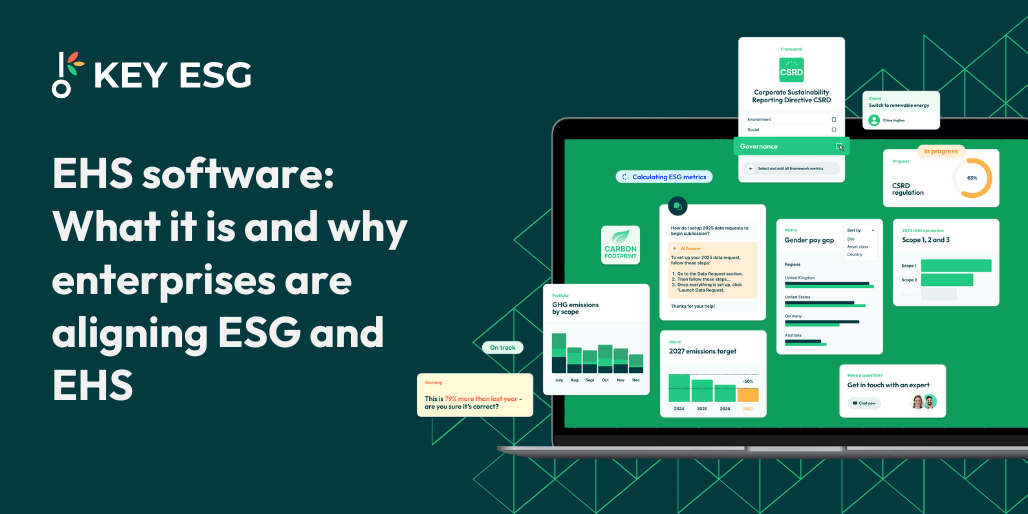Environment, health and safety (EHS) management is essential for organisations operating under strict regulation and increasing sustainability demands.
EHS management software provides a digital platform to track, manage, and improve health, safety, and environmental performance across the business. These solutions streamline compliance, strengthen safety culture, and reduce risk in complex industries such as manufacturing, energy, and logistics.
This article outlines what EHS software is, its key features, and how it supports wider sustainability and ESG objectives.
What is EHS software?
EHS software is a digital platform designed to manage and automate a business's environmental, health, and safety processes. It centralises critical data on workplace incidents, safety audits, and regulatory compliance activities, allowing teams to streamline processes and ensure that safety protocols are consistently followed. EHS regulations are complex and continually evolving, making it essential to use EHS management software to keep up with compliance requirements and mitigate risks.
By integrating incident tracking, automated incident reporting, tools to manage incidents efficiently, safety audits, compliance management, and sustainability initiatives, EHS software supports enterprises in maintaining high health, safety, and quality standards. It also enables organisations to address environmental management aspects such as air quality and to implement risk assessment modules with effective controls to reduce hazards.
Additionally, EHS software helps organisations track scope 1, 2, and 3 emissions as part of their ESG and sustainability goals. These features matter for regulatory adherence, risk mitigation, and continuous improvement across operations.
Key components of EHS software
A comprehensive EHS software platform is built on several core components that support health and safety management, environmental performance, and regulatory compliance. These elements work together to reduce risk, simplify reporting, and align operational safety with sustainability goals.
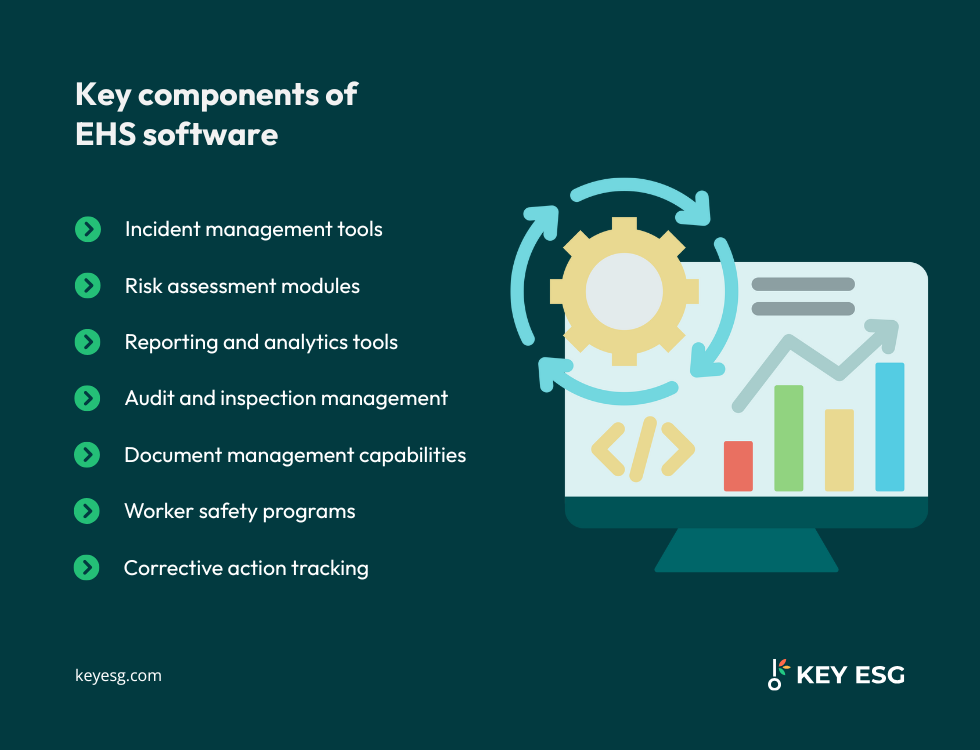
Incident management tools
Incident management modules capture and track workplace events in real time. Each incident is documented, investigated, and resolved, giving managers the visibility needed to identify patterns and implement corrective actions.
Risk assessment modules
Risk assessment tools help organisations evaluate and prioritise potential hazards based on likelihood and impact. This proactive approach reduces the chance of accidents and supports safer operations across high-risk environments.
Reporting and analytics
Integrated reporting and analytics provide insights into safety performance, highlight trends, and enable root cause analysis. By connecting this data with ESG reporting, enterprises can link operational safety improvements to wider sustainability objectives.
Audit and inspection management
Audit and inspection tools automate scheduling, execution, and follow-up. This ensures that compliance reviews are carried out consistently and that records remain up to date for both internal and external reporting purposes.
Document management
Centralised document management ensures safety policies, procedures, and training records are accurate and accessible. This reduces administrative effort and helps teams demonstrate compliance at all times.
Worker safety programmes
EHS software tracks the effectiveness of safety training and initiatives, ensuring employees follow required protocols. Regular monitoring supports continuous improvement and helps build a strong culture of safety.
Corrective action tracking
Corrective action tracking ensures issues are addressed and closed in line with regulatory standards. By monitoring follow-ups, organisations can strengthen safety processes and reduce compliance risks.
Strengthening risk mitigation with EHS software
One of the primary benefits of EHS software is its ability to strengthen risk mitigation strategies. With real-time incident tracking and safety metrics, businesses can identify potential hazards before they escalate into more serious risks. EHS software provides tools to report, analyse, and monitor workplace incidents, allowing managers to take prompt corrective actions. This proactive approach helps minimise injuries, environmental damage, and operational disruptions.
Moreover, EHS software offers a centralised board, making it easier for EHS managers and compliance teams to oversee various safety initiatives. By leveraging data analytics, businesses can identify patterns in safety incidents, assess risks, and implement preventive measures. This level of visibility ensures that enterprises are better equipped to handle high-risk scenarios and reduce their overall exposure to safety incidents.
In the context of broader corporate sustainability goals, the insights from EHS software are also critical for meeting reporting requirements like those outlined in the Corporate Sustainability Reporting Directive (CSRD), helping businesses align their safety practices with sustainability objectives.
For more information on CSRD, click here to read our Whitepaper: What is CSRD? Frequently asked questions.
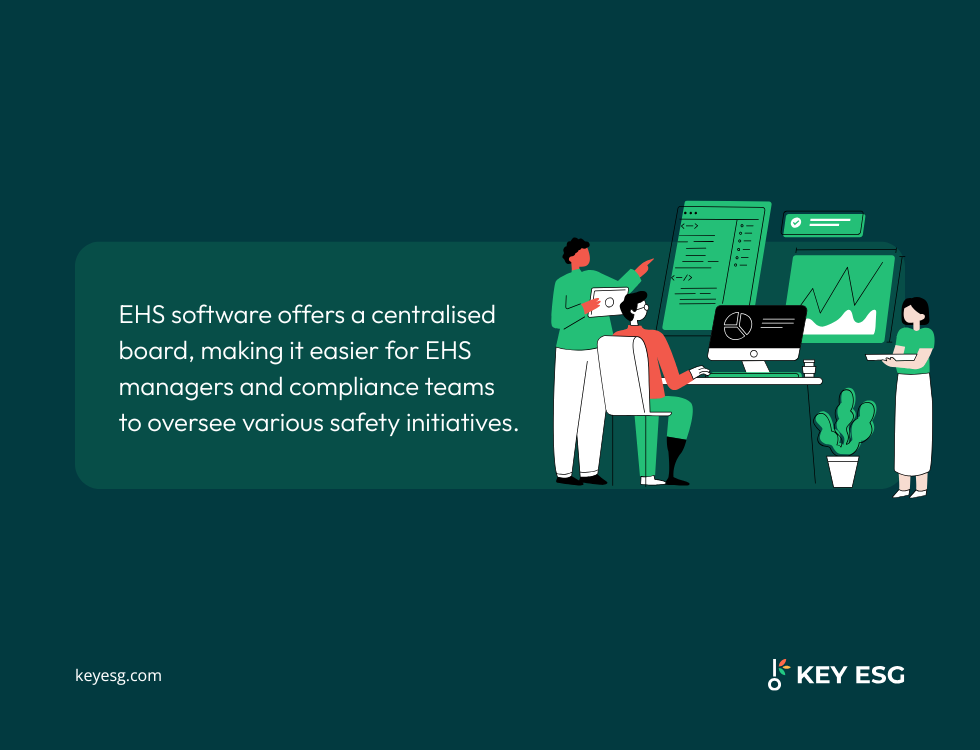
Digitising safety management for proactive decisions and streamlined regulatory compliance
Digitising EHS processes gives organisations faster access to accurate safety data. Incidents can be tracked in real time, hazards identified, and trends analysed across sites and teams. Automated workflows ensure consistent processes, while alerts and notifications allow rapid responses to emerging risks.
Centralised data also supports predictive analytics, enabling managers to anticipate potential issues and implement preventive actions. This proactive approach improves safety outcomes and reduces operational inefficiencies.
When integrated with ESG reporting, digital EHS systems provide the data required for CSRD, SFDR and IFRS S1 and S2 reports.This makes EHS software a key enabler of both regulatory compliance and informed, sustainability-focused decision-making.
How can EHS reporting be integrated with ESG goals?
A recent KEY ESG and HSI webinar with Verdantix shows that aligning ESG and EHS strategies delivers measurable business benefits. Verdantix research highlights that organisations with integrated ESG–EHS data achieve stronger governance oversight, improved data confidence, and clearer risk visibility across operations.
This alignment also helps companies move from compliance-driven reporting to performance-driven sustainability management, using operational safety and environmental data to track progress against corporate ESG targets. Insights from Verdantix’s report make a compelling case: integrated systems don’t just simplify reporting; they accelerate ESG initiatives and strengthen governance criteria across the enterprise.
Here is some of the data from Verdantix’s Global Corporate Survey 2025: ESG & Sustainability Budgets, Priorities and Tech Preferences.
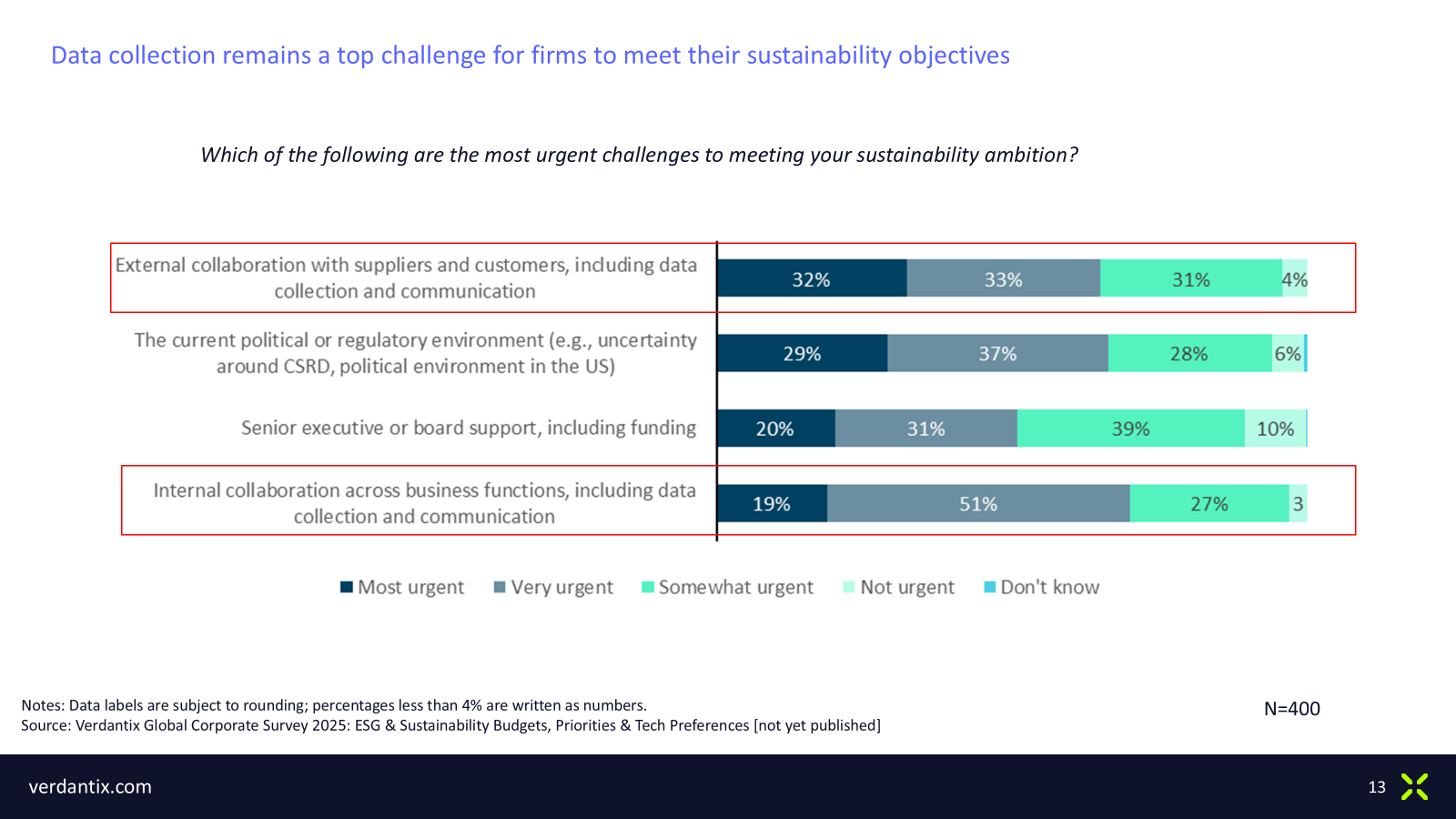
This data demonstrates that sustainability data collection, both internally and across supply chains, remains a key focus and challenge for many organisations. Addressing this challenge is the key to an organisation achieving its sustainability objectives. This makes a compelling case for unifying the data collection process across ESG and EHS teams, building collaboration, organisational buy-in and a unified process to data aggregation. Ensuring that EHS and ESG teams are equipped with a suitable software platform is fundamental to this process.
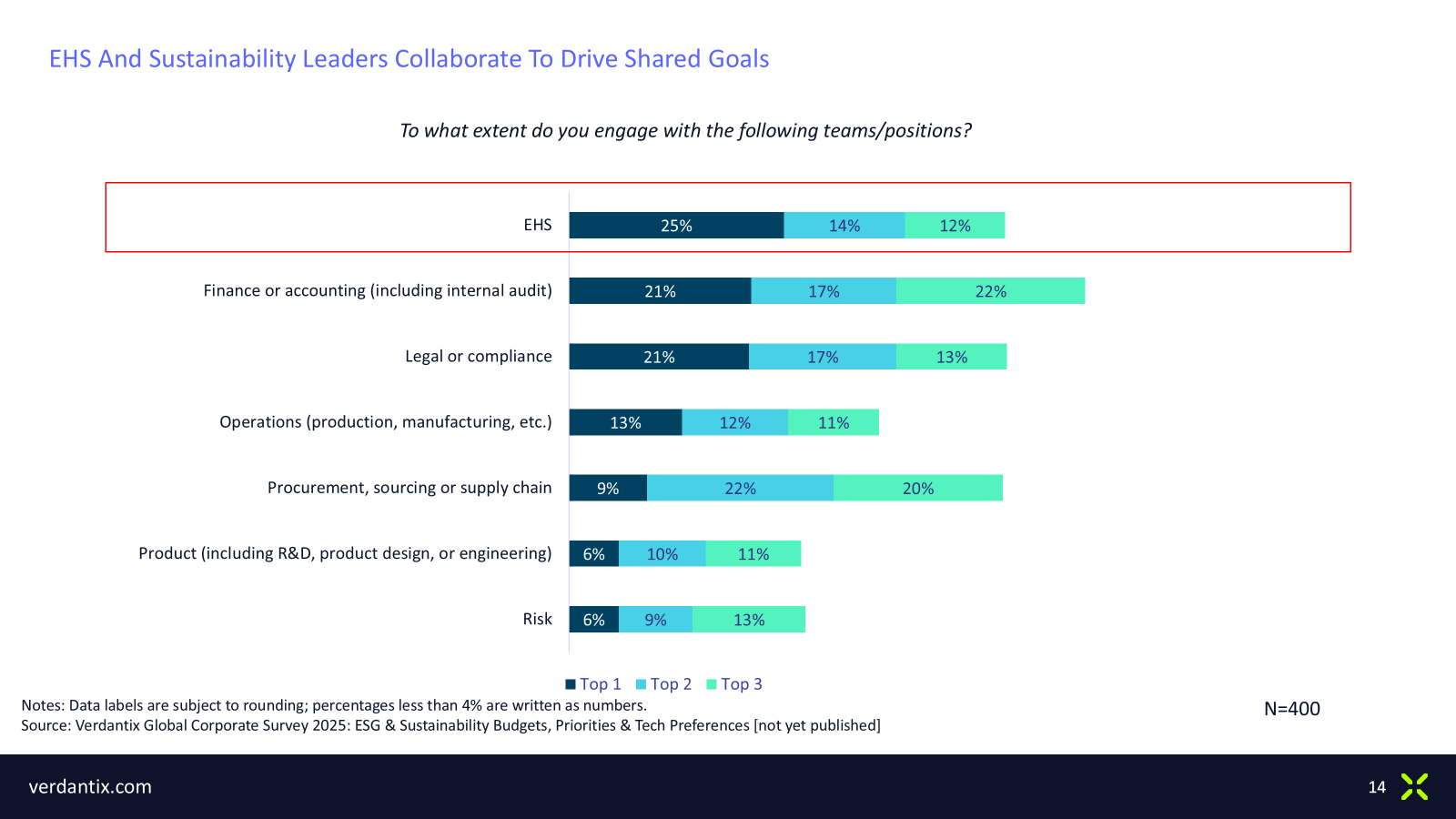
Similarly, this data shows that ESG and EHS teams are already closely aligned, making it strategically valuable to unify their software systems.
KEY ESG plays a crucial role in this integration by enabling cross-functional collaboration on ESG and EHS data collection processes. The intuitive platform caters to EHS and ESG professionals, as well as business users who have less subject matter expertise.
Best practices for ESG and EHS alignment
Successful ESG and ESG alignment requires a strategic approach that balances technology, people, and processes. The following best practices can help ensure a smooth and effective rollout of your strategy:
- Define clear goals and objectives: Align EHS program goals with sustainability priorities and regulatory requirements for a focused approach.
- Engage key stakeholders early: Involve relevant team members from the beginning to gather input on system requirements and workflows.
- Provide comprehensive training: Ensure users receive adequate training to build confidence and capability in using new software and reporting processes.
- Choose a scalable solution: Choose a solution that can grow with your organisation and adapt to evolving business needs.
- Integrate with other business systems: Connect the ESG platform with HR, ERP, and other systems to improve efficiency and data accuracy.
- Implement change management strategies: Address concerns and encourage adoption of new processes through a structured change management approach.
By following these best practices, organisations can mitigate risks, enhance environmental performance, and ensure that their ESG & EHS initiatives deliver lasting value and continuous improvement.
Leverage KEY ESG to align ESG and EHS initiatives
By aligning EHS reporting with broader sustainability goals and integrating with software like KEY ESG, enterprises can integrate their safety initiatives into their sustainability strategies, further enhancing their commitment to responsible business practices.
At KEY ESG, our software automates and streamlines ESG data management, allowing enterprises to gain the insights they need for EHS processes and broader corporate sustainability goals.
Ready to align your EHS and ESG reporting processes? Request a demo today.
Environment, health and safety (EHS) management is essential for organisations operating under strict regulation and increasing sustainability demands.
EHS management software provides a digital platform to track, manage, and improve health, safety, and environmental performance across the business. These solutions streamline compliance, strengthen safety culture, and reduce risk in complex industries such as manufacturing, energy, and logistics.
This article outlines what EHS software is, its key features, and how it supports wider sustainability and ESG objectives.
What is EHS software?
EHS software is a digital platform designed to manage and automate a business's environmental, health, and safety processes. It centralises critical data on workplace incidents, safety audits, and regulatory compliance activities, allowing teams to streamline processes and ensure that safety protocols are consistently followed. EHS regulations are complex and continually evolving, making it essential to use EHS management software to keep up with compliance requirements and mitigate risks.
By integrating incident tracking, automated incident reporting, tools to manage incidents efficiently, safety audits, compliance management, and sustainability initiatives, EHS software supports enterprises in maintaining high health, safety, and quality standards. It also enables organisations to address environmental management aspects such as air quality and to implement risk assessment modules with effective controls to reduce hazards.
Additionally, EHS software helps organisations track scope 1, 2, and 3 emissions as part of their ESG and sustainability goals. These features matter for regulatory adherence, risk mitigation, and continuous improvement across operations.
Key components of EHS software
A comprehensive EHS software platform is built on several core components that support health and safety management, environmental performance, and regulatory compliance. These elements work together to reduce risk, simplify reporting, and align operational safety with sustainability goals.

Incident management tools
Incident management modules capture and track workplace events in real time. Each incident is documented, investigated, and resolved, giving managers the visibility needed to identify patterns and implement corrective actions.
Risk assessment modules
Risk assessment tools help organisations evaluate and prioritise potential hazards based on likelihood and impact. This proactive approach reduces the chance of accidents and supports safer operations across high-risk environments.
Reporting and analytics
Integrated reporting and analytics provide insights into safety performance, highlight trends, and enable root cause analysis. By connecting this data with ESG reporting, enterprises can link operational safety improvements to wider sustainability objectives.
Audit and inspection management
Audit and inspection tools automate scheduling, execution, and follow-up. This ensures that compliance reviews are carried out consistently and that records remain up to date for both internal and external reporting purposes.
Document management
Centralised document management ensures safety policies, procedures, and training records are accurate and accessible. This reduces administrative effort and helps teams demonstrate compliance at all times.
Worker safety programmes
EHS software tracks the effectiveness of safety training and initiatives, ensuring employees follow required protocols. Regular monitoring supports continuous improvement and helps build a strong culture of safety.
Corrective action tracking
Corrective action tracking ensures issues are addressed and closed in line with regulatory standards. By monitoring follow-ups, organisations can strengthen safety processes and reduce compliance risks.
Strengthening risk mitigation with EHS software
One of the primary benefits of EHS software is its ability to strengthen risk mitigation strategies. With real-time incident tracking and safety metrics, businesses can identify potential hazards before they escalate into more serious risks. EHS software provides tools to report, analyse, and monitor workplace incidents, allowing managers to take prompt corrective actions. This proactive approach helps minimise injuries, environmental damage, and operational disruptions.
Moreover, EHS software offers a centralised board, making it easier for EHS managers and compliance teams to oversee various safety initiatives. By leveraging data analytics, businesses can identify patterns in safety incidents, assess risks, and implement preventive measures. This level of visibility ensures that enterprises are better equipped to handle high-risk scenarios and reduce their overall exposure to safety incidents.
In the context of broader corporate sustainability goals, the insights from EHS software are also critical for meeting reporting requirements like those outlined in the Corporate Sustainability Reporting Directive (CSRD), helping businesses align their safety practices with sustainability objectives.
For more information on CSRD, click here to read our Whitepaper: What is CSRD? Frequently asked questions.

Digitising safety management for proactive decisions and streamlined regulatory compliance
Digitising EHS processes gives organisations faster access to accurate safety data. Incidents can be tracked in real time, hazards identified, and trends analysed across sites and teams. Automated workflows ensure consistent processes, while alerts and notifications allow rapid responses to emerging risks.
Centralised data also supports predictive analytics, enabling managers to anticipate potential issues and implement preventive actions. This proactive approach improves safety outcomes and reduces operational inefficiencies.
When integrated with ESG reporting, digital EHS systems provide the data required for CSRD, SFDR and IFRS S1 and S2 reports.This makes EHS software a key enabler of both regulatory compliance and informed, sustainability-focused decision-making.
How can EHS reporting be integrated with ESG goals?
A recent KEY ESG and HSI webinar with Verdantix shows that aligning ESG and EHS strategies delivers measurable business benefits. Verdantix research highlights that organisations with integrated ESG–EHS data achieve stronger governance oversight, improved data confidence, and clearer risk visibility across operations.
This alignment also helps companies move from compliance-driven reporting to performance-driven sustainability management, using operational safety and environmental data to track progress against corporate ESG targets. Insights from Verdantix’s report make a compelling case: integrated systems don’t just simplify reporting; they accelerate ESG initiatives and strengthen governance criteria across the enterprise.
Here is some of the data from Verdantix’s Global Corporate Survey 2025: ESG & Sustainability Budgets, Priorities and Tech Preferences.

This data demonstrates that sustainability data collection, both internally and across supply chains, remains a key focus and challenge for many organisations. Addressing this challenge is the key to an organisation achieving its sustainability objectives. This makes a compelling case for unifying the data collection process across ESG and EHS teams, building collaboration, organisational buy-in and a unified process to data aggregation. Ensuring that EHS and ESG teams are equipped with a suitable software platform is fundamental to this process.

Similarly, this data shows that ESG and EHS teams are already closely aligned, making it strategically valuable to unify their software systems.
KEY ESG plays a crucial role in this integration by enabling cross-functional collaboration on ESG and EHS data collection processes. The intuitive platform caters to EHS and ESG professionals, as well as business users who have less subject matter expertise.
Best practices for ESG and EHS alignment
Successful ESG and ESG alignment requires a strategic approach that balances technology, people, and processes. The following best practices can help ensure a smooth and effective rollout of your strategy:
- Define clear goals and objectives: Align EHS program goals with sustainability priorities and regulatory requirements for a focused approach.
- Engage key stakeholders early: Involve relevant team members from the beginning to gather input on system requirements and workflows.
- Provide comprehensive training: Ensure users receive adequate training to build confidence and capability in using new software and reporting processes.
- Choose a scalable solution: Choose a solution that can grow with your organisation and adapt to evolving business needs.
- Integrate with other business systems: Connect the ESG platform with HR, ERP, and other systems to improve efficiency and data accuracy.
- Implement change management strategies: Address concerns and encourage adoption of new processes through a structured change management approach.
By following these best practices, organisations can mitigate risks, enhance environmental performance, and ensure that their ESG & EHS initiatives deliver lasting value and continuous improvement.
Leverage KEY ESG to align ESG and EHS initiatives
By aligning EHS reporting with broader sustainability goals and integrating with software like KEY ESG, enterprises can integrate their safety initiatives into their sustainability strategies, further enhancing their commitment to responsible business practices.
At KEY ESG, our software automates and streamlines ESG data management, allowing enterprises to gain the insights they need for EHS processes and broader corporate sustainability goals.
Ready to align your EHS and ESG reporting processes? Request a demo today.


